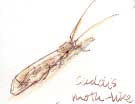Ever Decreasing CirclesThursday, 26th August 2004 |
The Cathedral's crocketed spire, built c.1420, is still the signature feature of the Wakefield skyline. The Town Hall, built 1877-80, was described in The Building News of the time as the work of a 'true Gothicist', the design more Jacobean than Renaissance: '. . . the clock tower,' the critic continued, 'is thoroughly mediaeval and severe in character - almost too much so . . . '
I'm looking forward to taking part in a Readers' Festival at the Town Hall in October with not a little foreboding in case the venue for my workshop on book illustration is the dark-panelled Kingswood Suite; a room that will always have a sinister quality for me because of its associations with my mysteriously disappearing evidence (lost by the Council's planning department) and the threats made against me if I tried to make good its loss by giving my evidence - which was described as both 'unbelievable' and 'unimportant' - in person (£250,000 plus costs were mentioned, which I found scary). Sorry, if you're a regular reader, you've heard all this before! 'They're creepy and they're spooky' was the way the Addams Family were introduced in the 1960s television comedy but it's Wakefield Town Hall that still sends shivers down my spine. * * * * * In my imagination I might be searching for meaning in the everyday, exploring the complexity of nature and contemplating the mysteries of time but I'm aware that in real life I lead a semi-detached suburban existence: The Greengrass of Home
'What have I married?!' said Barbara when she saw the photographic evidence.
|
Like Trees in NovemberOn just one occasion I worked on the same production as Richard Briers: he voiced one of the leading characters, the visionary rabbit Fiver, in the 1978 cartoon film of Richard Adams' Watership Down. In this scene Fiver is filled with foreboding and stammers that he feels that the strange rabbits in Cowslip's Warren are 'sad, like trees in November'. The pen and ink drawing of roots and pebbles was my contribution to this scene: the colouring was the work of another artist in the background department while Fiver himself was drawn by an animator. |
|

 Caddis
Fly
Caddis
FlyAttracted by the light, a Caddis fly, flies in through the back door. As it flutters past me, I think it's a kind of moth but then it settles on the fridge door and I'm able to get a better look at it.
I think of this creature's larval life in the beck beyond the meadow: making a case for itself out of fragments of vegetation, clinging to a rock in the stream and catching the food particles that drift past it in the current.
Then it starts it's new life, as an adult insect, in the new element
of air; it flies out of the wood, across the meadow, in through our open
door and ends up clinging, like a magnet, to our fridge door. ![]()
Claude Jeremiah Greengrass and Nicolas Rhea's Heartbeat novels.
Ever Decreasing Circles at nostalgiacentral.com
A film is not a book - Watership Down comes to the screen, an essay by Chris Boyce who includes a link to 'A piece of web gold dust and another by Richard Bell, one of the film’s background artists (a fact he had revealed in his 1980's book, Richard Bell's Britain) clearly shows the style and detail of the Cowslip's warren sequence dates from the Hubley year.' Chris has come up with a lot about the making of the movie that not even I knew about, my thanks to him for bringing together so much background material (and for referring to my page as 'web gold dust'!).
Hubley and Rosen
For the record though; Hubley interviewed me and offered me a job as assistant background artist at the beginning of the summer of 1976 but by the time I started work in September he was gone and I'm sorry that I never got to work with him (nor did I work alongside veteran Disney animator Phil Duncan, who I met when I was down for the interview, as he had gone off on a long vacation to some exotic location by the time I started work).
Chris is right in stating that Hubley had a huge influence on the look of the film and that it was Rosen who tightened up the storytelling side of things. I think you see Hubley's influence most in the mythological, playful sequences and Rosen's in the dark and violent side of the film (not that Rosen was dark and violent man to work with as producer/director, you understand!).
There was a lovely story-within-a-story of El-ahrairah and the King's Cabbages which was virtually complete but which had to be cut because of the long running time of the film. I felt it should have been released as a short film in its own right. Wonder if it's still sitting in a vault somewhere?
Richard Bell, richard@willowisland.co.uk